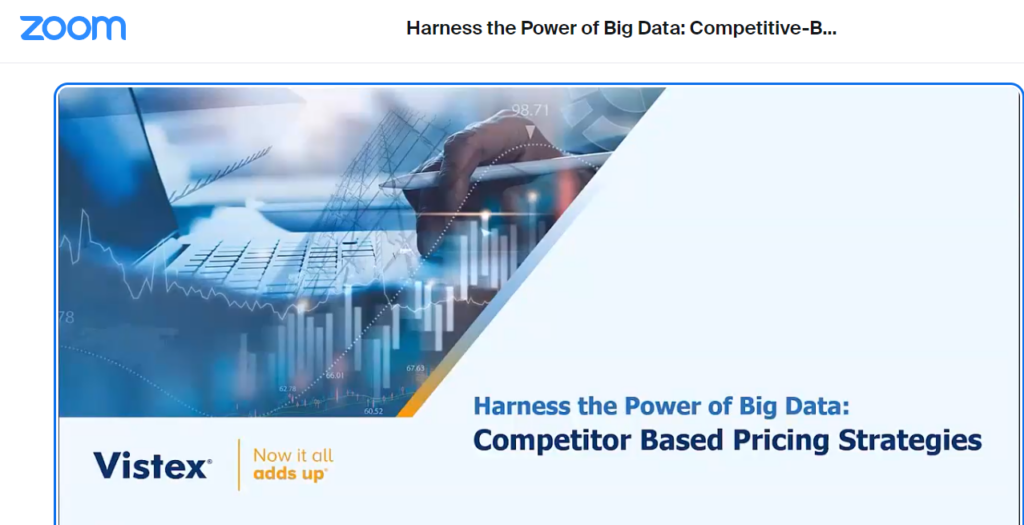
Vistex: How Companies Can Use Competitive Data to Improve Their Positions Online
In the current market, it is increasingly difficult for many companies to carry out their market-oriented strategies, such as price setting, Brian Sherry, senior pricing advisor at Vistex, said May 17, during the webinar “Harness the Power of Big Data: Competitive-Based Pricing Strategies.”
Some companies have been able to solve that problem and gain a competitive advantage by using automation combined with big data, according to Sherry.
During the webinar, he explained how companies in the e-commerce sector can get started with using competitive data to improve their positions in the market.
Sherry, who has more than 20 years of experience in B2B and B2C pricing, provided advice he has learned from working with companies including Microsoft and Sony on pricing strategies that he said helped secure their margins and win market share from rivals.
 “What is a competitor-based pricing strategy?” he asked attendees rhetorically. “Basically, there are three main pricing strategies that are used by companies,” he said. “As you can see from this table, a competitor-based pricing strategy is sometimes referred to as a market-based strategy and is one of the main approaches that companies can use to set the prices of its products.”
“What is a competitor-based pricing strategy?” he asked attendees rhetorically. “Basically, there are three main pricing strategies that are used by companies,” he said. “As you can see from this table, a competitor-based pricing strategy is sometimes referred to as a market-based strategy and is one of the main approaches that companies can use to set the prices of its products.”
The other main strategies for setting prices are cost-based pricing, which calculates prices based on cost plus a predetermined margin, and value-based pricing, which sets prices based on an estimate of how companies value their goods and services, he noted.
“In terms of a definition, a competitive-based pricing strategy is simply defined as a price-setting strategy that is based on your competitor’s prices,” he explained. “Essentially, it is a pricing strategy that uses competitor’s prices as the primary data set to make price decisions. This pricing approach is generally regarded to be superior to cost-based placing as it moves your pricing strategies from an internal focus to more of an external or market-orientated focus.”
However, he said: “It is worth remembering that cost-based pricing, competitor-based pricing, and also value-based pricing are purist pricing approaches. In reality, most companies are not purists. While they may have a dominant philosophy, they do not use any one approach a hundred percent of the time and will modify their approach to achieve different goals…. The reality is companies can combine these three types of pricing strategies together.”
Additionally, he said, it’s “also without doubt that the rise of e-commerce today has necessitated the ability for many companies to now manage and update places in a highly competitive, fast moving and transparent environment.”
Meanwhile, the “increased use of competitive-based pricing has been driven by the competitive nature and explosive growth of online retailing,” he noted, pointing out e-commerce has been “booming.”
In 2021, e-commerce represented almost 19% of retail sales and, by 2026, the online segment is expected to make up close to 25% of total retail sales, he said, noting the Covid-19 pandemic only drove online sales more.
“The shift towards online channels is unlikely to stop in the future,” he predicted. “However, despite the boom, it should also be remembered: E-commerce can be an incredibly challenging pricing environment for many companies to navigate, according to market research,” he said. And about 90% of e-commerce businesses end in failure within just 120 days, he pointed out.”
Among the top five reasons for their failure were price and cost issues, he noted. Nine percent of failed startup owners claimed that was the reason why they failed and another 23% said it was due to them being outperformed.
“The first challenge e-commerce B2C retailers need to face is price transparency,” he went on to say. “The internet has changed the way price information is disseminated. With just a few clicks, consumers are now able to obtain price information from multiple details and price aggregators. You can safely state that this increased price transparency has induced fierce competition among e-commerce companies. In addition, the price transparency of the internet means that whatever online pricing a company adopts, the details will be widely known within a truly short period by both its customers and competitors.”
Another major challenge is that the internet “increases the velocity of pricing decisions,” he pointed out.
 “Many companies that change prices once a month or less now find they face the daily challenge of determining what prices to display on their website,” he said. “Many companies are now beginning to struggle with this increased velocity and things are only going to get worse,” he predicted. But he added that it isn’t all negative for the online pricing world. After all, the internet also makes available an “immediate wealth of information about customer behavior that was formally unavailable or only available after a considerable time lag,” he said. That information includes who bought something and even who clicked on a specific thing at the website, he noted.
“Many companies that change prices once a month or less now find they face the daily challenge of determining what prices to display on their website,” he said. “Many companies are now beginning to struggle with this increased velocity and things are only going to get worse,” he predicted. But he added that it isn’t all negative for the online pricing world. After all, the internet also makes available an “immediate wealth of information about customer behavior that was formally unavailable or only available after a considerable time lag,” he said. That information includes who bought something and even who clicked on a specific thing at the website, he noted.
That information has been “increasingly captured and analyzed by companies, both to support cross-selling and upselling, and also to understand customer behavior and segmentation,” he said.
“The internet also has the potential to be an ideal authority for pricing experiments,” he said, adding: “It’s no surprise that pricing is considered as one of the most important factors for online consumers while making their final purchase decisions.” Additionally, the average online shopper will visit at least three websites before finalizing a purchase, he noted.
“In summary, with the arrival of e-commerce, consumer search costs have greatly shrunk as the prices of goods can now be compared on relatively transparent online markets,” he went on to say. “Therefore, online demand is increasingly influenced by the prices of your competitors, which you should therefore not ignore.”
In reaction to these trends, many online retailers have adopted competition-based pricing strategies in which they will now constantly monitor competitor’s prices and use this as an input in setting their own prices and following a competitor- based pricing strategy that monitors competitor’s pricing, he said.
He added: “With additional information about your competitors’ pricing and positioning in the market, the more focused you can become, including competitor- based pricing strategies in response to competitive pricing pressures.”
But the “first step is to determine who your competitors are,” he stressed, adding: “Next, you should analyze these competitors and research the pricing and positioning strategies. Perform a pricing analysis to dig into the pricing models and positioning strategies, and build a map for the current market pricing. This will help you understand what pricing and positioning your competitors are following. After researching your competitors’ pricing, you’re ready to determine where your product pricing should sit. Basically, when creating a competitive-based pricing strategy, you can choose to be higher, lower or offer matched prices compared to your competitors. Remember, when you develop any competitive pricing strategies, you should almost align them with your organizational goals.”
And “different goals will lead to different types of pricing strategies,” he added. “Depending on what your organization wants to achieve, there’ll be certain requirements that you may need to incorporate into your competitor-based pricing strategies. The next step is to validate. This is where you’re going to check your pricing strategies and simulate results before implementing. Finally, you’re going to reprice through implementing your pricing strategies and evaluate what happens. Based on the results, you’re going to continually test and refine your competitor-based pricing strategies.”
He also told viewers: “Pricing is both art and science, which means that a test and learn approach is crucial to getting it right.”
